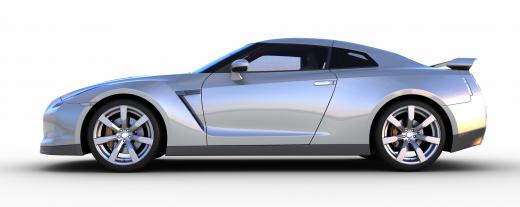What is Static Friction?
 Mary McMahon
Mary McMahon
Static friction is a force that resists the movement of two objects against one another when the objects are initially at rest. A simple example is a wooden block sitting on a ramp — a force needs to be applied to make the block slide down the ramp. Another term, kinetic friction, applies to the force that opposes objects that are already moving against one another. The strength of these forces can be calculated and is known as the coefficient of friction. In real-life situations, the coefficient of static friction is nearly always found to be greater than that for kinetic, but in carefully controlled experiments, where the surfaces of the objects have been thoroughly cleaned, the two are generally the same.
Typically, as the force applied to an object on a surface increases, the static friction force will initially increase to match it, so that the object does not move. After a certain point, however, the object will begin moving, and at this point, the friction force will drop, so that less force is required to keep the object moving. For example, the friction force may match the applied force up to 50 newtons — force is measured in newtons (N) — but thereafter, it may drop to 40 N. Therefore, a force of just over 50 N is required to get the object moving, but thereafter, just over 40 N will suffice.
Calculating the Coefficient

Static friction coefficients can be calculated for any solid material or pair of materials. A coefficient value might, therefore, apply to wood on wood, steel on steel, or steel on wood. One way of calculating the value for a pair of materials is to place a block of one material on a ramp made of the other — for a single material, the block and ramp would be made of the same substance. The slope on the ramp is gradually increased, until the block slides down. The angle at which this happens can then be used to calculate the coefficient of static friction.

The coefficient, when used in formulae and equations, is given the symbol μ — the Greek letter mu. A subscript is usually employed to distinguish the two: μs indicates static friction, while μk means kinetic friction. For example, the μs for steel on steel is 0.74, while the μk for this material is 0.57. These values are for typical real-life situations, and may vary a little, depending on circumstances. Since the μs value can be affected by surface irregularities, dirt, and traces of other substances, the μk value is regarded as more accurate, and is the one usually given when a simple coefficient of friction is required.
Factors Affecting Friction
A number of factors contribute to static friction, but usually the most important one is the roughness of the surfaces. Even when smoothed down, different materials will vary in terms of the fine details of their surfaces. In practical terms, no surface is completely smooth, but some will have larger irregularities than others. The difference is obvious, in some cases: for example, a silk sheet has a very smooth texture that creates less friction, while a dry asphalt road is coarse, generating more resistance to movement. Other factors include electrostatic attraction and the types of weak chemical bonds that can form between surfaces.
Examples
Many people are familiar with static friction, since they encounter it on an almost daily basis; for example, it is at work when someone slides a book across a table. Initially, a small amount of force needs to be exerted to get the book to move, but once it is moving, kinetic friction comes into play, and less effort will be required to move it. The amount of force required can vary according to circumstances. For example, if a book has a library cover on it and it got damp, the wet book will require more force to move, while a brand new paperback book might slide very easily across a dry wooden table with a varnished surface.
Tables of static and kinetic friction coefficients are available for many common materials and combinations thereof. A higher value indicates greater friction, so that more force needs to be applied to cause motion. For example, the μs for aluminum on aluminum is 1.05 – 1.35, which is very high, while the value for polytetrafluoroethylene (PTFE) on PTFE is 0.04, which is extremely low and makes it very slippery. It is difficult to push a stopped car into motion because of the intentional friction between the tires and the ground; this allows the driver more control and makes the car less likely to skid.
Calculating Braking Distance
One example of the application of static friction is in calculating the breaking distance for a car at a given speed and in particular conditions. In normal circumstances, when the tires are turning on the road, static, rather than kinetic, friction, applies. The μs for a dry tire on a dry road is about 1.00, whereas the value for a wet tire on a wet road is only 0.2 — this means that the breaking distance will be five times greater in wet conditions. In dry conditions, a car traveling at 31 miles per hour (50 kph) has a braking distance of 33 feet (10 meters), whereas in wet conditions, the braking distance would be 164 feet (50 meters). When the tires are sliding, rather than rolling, along the surface — as might be the case in icy conditions — it is kinetic friction that is important.
AS FEATURED ON:
AS FEATURED ON:












Discussion Comments
How is it good and bad for cars?
What are the applications of static friction?
What are the problems that we will encounter during conducting this experiment? E.g., about the set up of the degree of inclination maybe? Or how the thread used to pull the object might affect the object's movement?
Static friction keeps an object from moving (sliding, etc.) until a force sufficient to overcome it is applied to the object.
Every two objects in contact have a static friction coefficient, as well as a kinetic friction coefficient. The value of static friction is always between 0 and 1, as is the value for kinetic friction. Static friction between objects is always greater or equal to kinetic friction between them. That is, it takes more force to get an object moving despite friction than it does to keep an already moving object moving.
how is static friction useful?
I need a great demonstration on how to show static friction, sliding friction, and rolling friction! please help soon!
@anon114791 -- "take a balloon and rub it on yourself, then it will stay on you. that is an example of static friction.
^^^ Incorrect physics!! This is an example an electrostatic force, not static friction!!
it could help things from sliding.
What is a force? When you apply force on something, what do you put inside that? Put some energy, i.e. packages of photon that causes the motion or deformation etc?
when you drag an object, why does it take more newtons to make it move than when it is already moving?
take a balloon and rub it on yourself, then it will stay on you. that is an example of static friction.
what are some examples of static friction?
Static friction can be overcome by placing enough into one of two substances that are touching. the amount of energy needed must be greater than the coefficient of static friction times the normal force being applied to/by the objects.
does static friction speed up?
Static friction can be overcome by placing enough energy into one of two substances that are touching. The amount of energy needed must be greater than the coefficient of static friction (a constant variable dependent upon which two materials you have) times the normal force being applied to/by the objects.
how can you overcome static friction?
Static friction is useful for stuff like electric currents or electronics.
how is static friction useful?
Post your comments